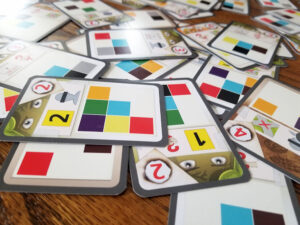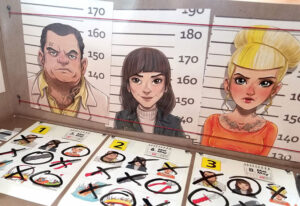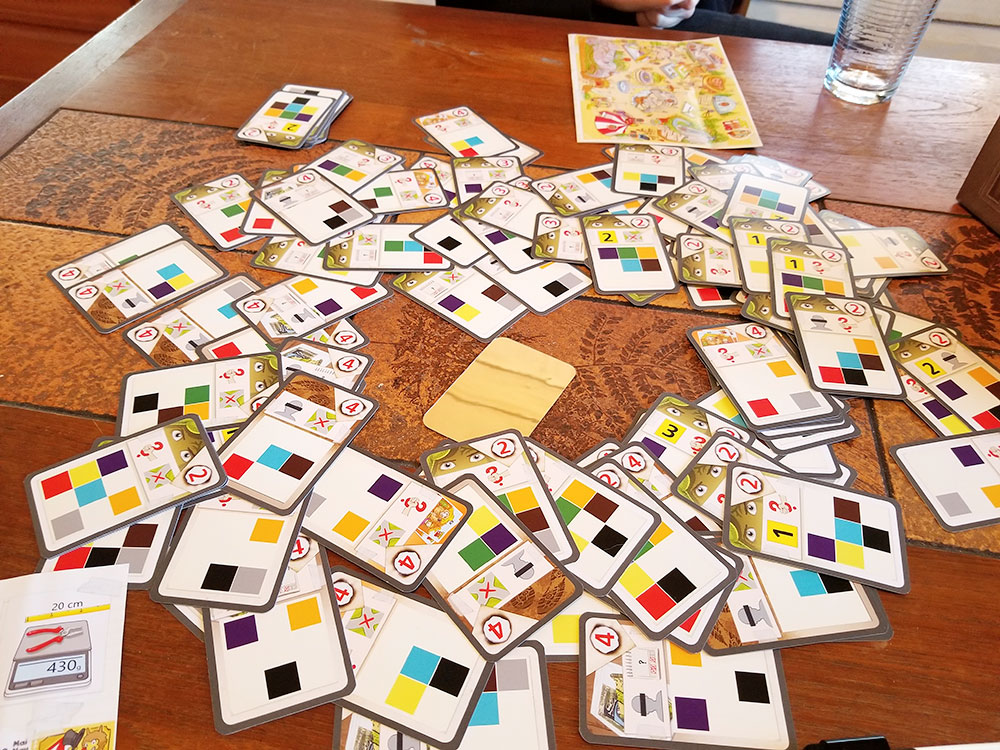 Sometimes seeing the designer’s name attached to a game can impact if you pick it up or not, even if you know very little about the game. That can be heightened even more when it’s a designer who has released one or more hot games in a recent time period. I remember this was how it was for Wolfgang Warsh after he designed The Mind.
Sometimes seeing the designer’s name attached to a game can impact if you pick it up or not, even if you know very little about the game. That can be heightened even more when it’s a designer who has released one or more hot games in a recent time period. I remember this was how it was for Wolfgang Warsh after he designed The Mind.
I didn’t know much about The Key: Sabotage at Lucky Llama Land when I first saw the cover. I always am willing to give HABA games a shot, but this looked much more mature than their usual offering. And then I looked up designer Thomas Sing’s other games. And there it was, sitting as his highest-ranked game: The Crew: Quest for Planet Nine. My eyes immediately lit up just on this one game that Mr. Sing designed to critical acclaim.
Gameplay Overview:
The Key is a game system centered around a deck of cards. See, The Key is a deduction series where players are looking to solve multiple parts of a crime. For Sabotage at Lucky Llama Land, three crimes have been committed at the park, all destruction of theme park rides. The players are tasked with figuring out which of the three criminals broke which ride, what tool they used to break it, and what day of the month they committed their crimes. Each piece of evidence can only be used once, so an example combination is that on May 6th, Gonzo Musone broke the roller coaster with a knife.

What do the cards do in play? Well first, we have to talk about the cases. Sabotage at Lucky Llama Land has nine potential cases, symbolized by different wooden keys that come in the box. A key is chosen at the start, and at the end of the game, the key’s color is linked to a solution. On one side of a cardboard solution board are sets of three digit combinations that link up to the solution you came up with. Based on the first person to complete the case, they grab the wooden key and if they have a three digit number that matches, you insert it into the lock’s hole. If, on the back, the color matches, that player could potentially win (I’ll explain more in a second).
Now I know what you’re thinking: why won’t he tell me about this deck of cards so central to the game? And to that, I will reward your patience with a description of the cards.
Cards in this game aren’t drawn, but put into an unorganized circular shape where the players may need to sift through the cards to see all their visible information. The information facing up is made up of a grid of colored squares and some symbols or numbers at the top. The symbols lead you toward what type of clue that particular card can help you solve. The numbers tell you how many points the card is worth during final scoring. And the grid of squares matches up with the same colors as the case keys. So in our above example, if the purple key was used, then all cards with a purple square navigate players toward a correct answer. All cards without one cannot be used and are junk cards that clutter the play space.

So I grab a card. It will tell me some sort of clue, whether written or visual, that will help me work toward solving the case. Written clues are simple information, things like the pliers were used before the knife or the person who committed the crime on the 8th of May wasn’t the shortest.
And I forgot to mention this whole thing is done in real time. Yes, there are no turns in The Key, but everyone is working to solve the same case. To win, the player must have the correct combination of numbers to be eligible, no matter how quickly they finished. So if the last person to finish is the only one who solves the case, then they win no matter what. If multiple people got it right, this is where scores are tallied. Whoever scores the lowest score is the winner in that case. If the player who finished the case first is eligible to win, they may discard the card in their possession with the lowest value, giving the first to finish a slight advantage (once again, if they were correct, so that may be a disadvantage after all).

Game Experience:
I’m quite the fan of deduction games, with Whitehall Mystery, Sherlock Holmes Consulting Detective, and A Fake Artist Goes to New York being some of my favorites in the different subgenres of deduction. The Key series is more of a traditional look at deduction, with some clever twists.
The real-time play provides a lot of tension, without being the end-all, be-all race to the finish. Players want to get that bonus for being first, but you also want to spend some time double checking if your leads actually connect to the solution you’ve written. The cards also use hints/evidence like you would see in some of the more involved games like Consulting Detective, but in a shorter form. Things like “the shortest person sabotaged first”, “Olivia sabotaged with a heavier tool than Jennifer”, or “a person with dark hair used the knife” are just a few examples of the types you’ll see on the text card.

The three other types of cards are focused more around awareness, process of elimination, and finding differences. These have higher values, but can point you in more of a direct answer, and can be a huge starting block when building a solution. I particularly like the clever use of an included mirror to determine which footprint is the exact match. There aren’t many uses of deduction like this, except maybe in escape room games.
The playtime is quick and consistent, always fitting within 20-30 minutes no matter the play count. The box also says for ages 8+, but I’ve not played with kids, so I can’t determine if the deduction is too far out of their wheelhouse. My guess is that most could grasp it, although I’ve also seen adults struggle as well.
A big gripe that many may see is the lack of variability. There are nine different cases included, but unlike games like MicroMacro CrimeCity or Consulting Detective, the cases aren’t featuring different characters, attractions, or crimes. Others might say that once you do one of the cases, you can’t return to it like those games I listed above, but this isn’t exactly like those. You may know the solution (which you’ll probably forget after you finish anyway), but you still have to have evidence to prove it. A BGG user rightfully put that for your first game in a case, you’re like a detective trying to find a solution, while future plays of that case are as if you are a lawyer who must present the evidence of what happened.
Maybe my biggest con with The Key is that it might have the most luck in a deduction game I have ever seen, which isn’t a common variable to juggle. On the surface, the luck is manageable, seeing that the side of the card that is up when spread about the table gives two pieces of direction as to what the other side will tell you. But more than once, the drawing of a card was accompanied by a groan when the items on the card was already-known information.
Final Thoughts:
Overall, I think The Key: Sabotage at Lucky Llama Land was a cool idea with a heavy emphasis on innovation. The fact that each of the cases have crossover cards is mind boggling as you think of the amount of time spent on ensuring that each card worked properly. The deduction itself is fun, particularly how the picture clues are so different from what I expect from the genre. I do feel like even though there are multiple cases, the feel of each game will not be very different. One could argue that if you want more variability, you could buy another entry in The Key series, but I am looking at this entry alone. Like other competitive deduction games, there is essentially no interaction, other than taking one of 140 cards that are spread out on the table.
Final Score: 3.5 stars – A fun deduction with a focus on innovation as opposed to wide variability.
 Hits:
Hits:
• Quick and consistent playtime with all player counts
• Real-time gameplay is fun, without giving the fastest player the automatic win
• Fun mix of clues
• Incredibly innovative deck system
Misses:
• Lack of variability between cases and plays
• Virtually no interaction
• Enough luck to leave a bad taste for fans of the genre





















